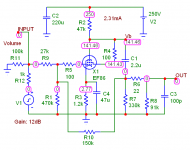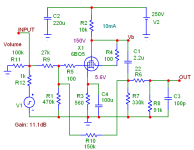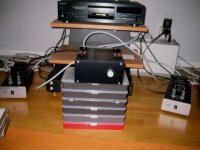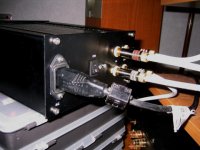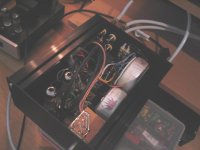man,
you guys ask the most difficult questions!
first of all, it all depends on what you are trying to accomplish... there is nothing at all wrong with using pentodes and the onesz you picked are pretty decent ones, too. but for a line stage? what does a line stage do? how much gain do you need? what impedance level are you working into? what source impedance are you receiving? before one even asks a question like, "are sharp cut-off pentodes any good for a line stage" you might want to ponder some other questions first?
the co**** answer is "yes, of course"! sharp cutoff pentodes are the ones you need for linear amplification and that is probably what you are more interested in. remote cutoff pentodes are better suited for things like compressors and AGC circuits or voltage controlled volume controls (yes you can make them with tubes...). these are all jobs that take advantage of the non-linear gain thats available in a remote cut-off tube. a line stage doesn't need much gain and there is a lot of gain available with the tubes you mentioned. they can be used in feedback circuits, there are some very interesting local feedback schemes for pentodes and they also make great cathode followers... useful for impedance matching. there are also some interesting direct coupled possibilities and you don't even have to put signal into the grid if you don't want to... there are 4 different input points on a pentode and they all have their pros/cons.
so now i hope you're satisfied?! you have opened a can of worms with your supposedly simple question...
happy new year!
jc
you guys ask the most difficult questions!
first of all, it all depends on what you are trying to accomplish... there is nothing at all wrong with using pentodes and the onesz you picked are pretty decent ones, too. but for a line stage? what does a line stage do? how much gain do you need? what impedance level are you working into? what source impedance are you receiving? before one even asks a question like, "are sharp cut-off pentodes any good for a line stage" you might want to ponder some other questions first?
the co**** answer is "yes, of course"! sharp cutoff pentodes are the ones you need for linear amplification and that is probably what you are more interested in. remote cutoff pentodes are better suited for things like compressors and AGC circuits or voltage controlled volume controls (yes you can make them with tubes...). these are all jobs that take advantage of the non-linear gain thats available in a remote cut-off tube. a line stage doesn't need much gain and there is a lot of gain available with the tubes you mentioned. they can be used in feedback circuits, there are some very interesting local feedback schemes for pentodes and they also make great cathode followers... useful for impedance matching. there are also some interesting direct coupled possibilities and you don't even have to put signal into the grid if you don't want to... there are 4 different input points on a pentode and they all have their pros/cons.
so now i hope you're satisfied?! you have opened a can of worms with your supposedly simple question...
happy new year!
jc
Gee... i guess i should have specified me a little bit... 
yes a linestage with lowish gain, in the order of 6-8 dB maximum.. more like a buffer that is.
well i was thinking "problem" more in terms of biasing, finding a linear workingpoint and other similar problems?
and maybe if someone have some input on the soundquality of these tubes, mine are Mullard ones. (that means not automatically good sound....)
thanks!
yes a linestage with lowish gain, in the order of 6-8 dB maximum.. more like a buffer that is.
well i was thinking "problem" more in terms of biasing, finding a linear workingpoint and other similar problems?
and maybe if someone have some input on the soundquality of these tubes, mine are Mullard ones. (that means not automatically good sound....)
thanks!
i may be the only one on this forum to say it but i will keep saying it... as far as the "sound" goes, its NOT the tubes... or at least not mostly. among the special or selected tubes this will vary.... its is what you DO with them. mullard (which is to say philips), made some good tubes... the best "mullards" were sometimes from other factories in other places... (like the 1970's "made in britain" matsushita EL-34s that everyone loves so much!) chances are you have some good stuff. so what are you going to make with them?

jc
jc
(like the 1970's "made in britain" matsushita EL-34s that everyone loves so much!)
Yeah, like the Westinghouse EL34's made in Japan Matsushita ones that I loved soo much!
Wayne
@ Mr. Triatic
In staying on topic, the 6CB6 is a good choice as also a 6EJ7 and a 12BY7 video pentode. And there are alot of the 4V and 5V versions which are plentiful and fairly inexpensive. Microphonics may a problem though. Using sharp cutoff pentodes, there will be a lot of gain and a high-ish output impeadance. You could "strap" them into triode mode, lower gain, less noise, and lower output imp. Either way you may want/need to use a cathode follower (dirty word around here!) with some, especially in pentode mode.
In that case you could use one of those made for TV use triode - pentodes with a little NFB around them. Such as 6U8, 6KD8, 6GH8, 6EA8, 6HG8, 6BR8, 6BL8, 6CL8, 6KE8 and the 4 and 5V versions etc. Hey IMO all tubes can be used for audio. It's just that some are better suited for audio than others. I think it would be fun to see what you can come up with! That's what DIY is all about!
Cheers
Wayne
In staying on topic, the 6CB6 is a good choice as also a 6EJ7 and a 12BY7 video pentode. And there are alot of the 4V and 5V versions which are plentiful and fairly inexpensive. Microphonics may a problem though. Using sharp cutoff pentodes, there will be a lot of gain and a high-ish output impeadance. You could "strap" them into triode mode, lower gain, less noise, and lower output imp. Either way you may want/need to use a cathode follower (dirty word around here!) with some, especially in pentode mode.
In that case you could use one of those made for TV use triode - pentodes with a little NFB around them. Such as 6U8, 6KD8, 6GH8, 6EA8, 6HG8, 6BR8, 6BL8, 6CL8, 6KE8 and the 4 and 5V versions etc. Hey IMO all tubes can be used for audio. It's just that some are better suited for audio than others. I think it would be fun to see what you can come up with! That's what DIY is all about!

Cheers
Wayne
yes a linestage with lowish gain, in the order of 6-8 dB maximum.. more like a buffer that is.
Missed that! Well in that case you would definitely need to strap them into (pseudo) triode mode. I would suggest a EL84/6BQ5, 6AQ5, 12BY7 and the like. A 6AQ5 strapped as a triode would have a mu of around 9 with a plate voltage of 250V and plate current of 49.5mA at -12.5V grid voltage! That's quite a bit of current! Of course you could go with a lower plate voltage with the resultant lower plate current. Don't have the exact numbers in front of me at the moment. I'd have to draw me a load line for this. Could do a simulation with an EL84 to get you in the ballpark. I'll try to do one and post back the results if you are interested.
Wayne
hi, thanks for the replies, i have decided to go for the 6as6, just for the size of it, if that wont work i aim for a configuration with 6cb6..
but i'm not really sure about the right way to "strap" a pentode into triodemode..?
due to these tubes small size i will be able to make a compact "module" to put in my existing passive preamp
but i'm not really sure about the right way to "strap" a pentode into triodemode..?
due to these tubes small size i will be able to make a compact "module" to put in my existing passive preamp
Hi Mr. Triatic!
I have a few treats for you! Ok, you want around 6->8dB of gain. And:
Don't you know it's not the size that counts??? But seriously... A 6AS6 is a dual control RF pentode. To quote the description from the Tung-Sol data sheet;
But seriously... A 6AS6 is a dual control RF pentode. To quote the description from the Tung-Sol data sheet;
"The 6AS6 is a sharp cut-off voltage amplifier...Low capacitance and high transconductance. The suppressor grid is terminated in a separate base connection and is intended to be used as an additional control grid in gating, switching, or mixer service."
If you don't have the data sheet go here to download a few:
http://home.wxs.nl/~frank.philipse/frank/frank.html
Haven't laid eyes on one of those in a long time! Do a little math and you will come up with your operating point. But the data sheets for the 6AS6 doesn't contain the characteristics of the tube in triode mode. So a bit of complicated math may be involved... that stuff makes my head hurt!
I've done a few simulations in MicroCap, but only with the EF86 and the 6BQ5/EL84. Those are the only decent models of sharp cut-off pentodes I have besides the EL34 etc. I'll get around to making a few of my own someday.
Now down to the nitty-gritty!
Place a 100 ohm or thereabouts between (going from) the screen grid to the anode. Since you need only 6-8dB of gain with these types, you will have to apply quite a bit of NFB around the tube. This is what I have done in my simulations. And also with the cathode resistor bypassed and unbypassed. Bypassing the cathode resistor will result in a lower output impeadence but also higher gain. There is always a little trade-off in the world of electronics. Now since I could not sim the 6AS6, The EF86, which by the way is a very good audio pentode, and the EL84 I simulated should give you a general idea as how to proceed.
The maximum rated anode voltage for the 6AS6 is 180V, 140V for g2 (screen grid). So therefore you would want to bias, set the operating condition so as to have approximately 66% of your supply voltage minus the cathode voltage. For example if you have a supply voltage (B+) of 180V, you would want around 120V sitting on the anode and nearly the same on g2, between the anode and the cathode in triode mode. I'd say you could use up to a 220V supply without any problems.
IMHO I wouldn't choose the 6AS6. The 6CB6 would be a better choice I would think, but hey go for it! You could use g3 for some interesting duties. Another subject for another time!
The schematics for the EF86 could be used for a 6AU6, should be pretty close with maybe some tweaking of the anode (load) resistor and the cathode resistor. Same for the 6CB6. So have a look at the schematics that I will be attaching and feel free to ask any questions you may have! I see from your profile you are into hamradio, tubed or sand?
I have a few treats for you! Ok, you want around 6->8dB of gain. And:
i have decided to go for the 6as6, just for the size of it,
Don't you know it's not the size that counts???
"The 6AS6 is a sharp cut-off voltage amplifier...Low capacitance and high transconductance. The suppressor grid is terminated in a separate base connection and is intended to be used as an additional control grid in gating, switching, or mixer service."
If you don't have the data sheet go here to download a few:
http://home.wxs.nl/~frank.philipse/frank/frank.html
Haven't laid eyes on one of those in a long time! Do a little math and you will come up with your operating point. But the data sheets for the 6AS6 doesn't contain the characteristics of the tube in triode mode. So a bit of complicated math may be involved... that stuff makes my head hurt!
I've done a few simulations in MicroCap, but only with the EF86 and the 6BQ5/EL84. Those are the only decent models of sharp cut-off pentodes I have besides the EL34 etc. I'll get around to making a few of my own someday.
Now down to the nitty-gritty!
but i'm not really sure about the right way to "strap" a pentode into triodemode..?
Place a 100 ohm or thereabouts between (going from) the screen grid to the anode. Since you need only 6-8dB of gain with these types, you will have to apply quite a bit of NFB around the tube. This is what I have done in my simulations. And also with the cathode resistor bypassed and unbypassed. Bypassing the cathode resistor will result in a lower output impeadence but also higher gain. There is always a little trade-off in the world of electronics. Now since I could not sim the 6AS6, The EF86, which by the way is a very good audio pentode, and the EL84 I simulated should give you a general idea as how to proceed.
The maximum rated anode voltage for the 6AS6 is 180V, 140V for g2 (screen grid). So therefore you would want to bias, set the operating condition so as to have approximately 66% of your supply voltage minus the cathode voltage. For example if you have a supply voltage (B+) of 180V, you would want around 120V sitting on the anode and nearly the same on g2, between the anode and the cathode in triode mode. I'd say you could use up to a 220V supply without any problems.
IMHO I wouldn't choose the 6AS6. The 6CB6 would be a better choice I would think, but hey go for it! You could use g3 for some interesting duties. Another subject for another time!
The schematics for the EF86 could be used for a 6AU6, should be pretty close with maybe some tweaking of the anode (load) resistor and the cathode resistor. Same for the 6CB6. So have a look at the schematics that I will be attaching and feel free to ask any questions you may have! I see from your profile you are into hamradio, tubed or sand?
Attachments
The first schematic was an EF86 strapped in triode mode at 2.31mA with the cathode resistor bypassed. You can leave out the bypass cap (47µf) and reduce the gain to 10dB but at the same time it will raise the output impedance. You could use a 6CB6 in it's place but you will have to adjust the anode and the cathode resistors. This schem should "mate" up well with a 6AU6!
And another reason I would prefer to use a 6CB6 is the much higher permissible operating voltages! The bad thing is that I don't have any curves of the 6CB6 operating in triode mode. If I had a good spice model/subcircuit I could derive a few curves.
Now this is a schematic using an EL84 in place of the EF86. Hope this gives you some good ideas and gets you in the ballpark!
Cheers
Wayne
And another reason I would prefer to use a 6CB6 is the much higher permissible operating voltages! The bad thing is that I don't have any curves of the 6CB6 operating in triode mode. If I had a good spice model/subcircuit I could derive a few curves.

Now this is a schematic using an EL84 in place of the EF86. Hope this gives you some good ideas and gets you in the ballpark!

Cheers
Wayne
Attachments
Hi there..........I regulary use the 7199 SCP in my amps....because of it's sharp-cut-off one can drastically reduce the value of R/C (stability phase correction) in the anode of the pentode section to a nice respectable value with plenty of phase error to spare. The effect is a far transparent sound. This snippet may be above the ability of others to engineer this on the bench, (requires test equip) but the opportunities of SCP do offer superb midrange & upper sound qualities.
rich
rich
Hey guys! thanks for the circuits cogsncogs!!
this morning i woke up with SRPP on my mind..
so i went for a "simple" SRPP with 6CB6 with 130V on the plate and 180 ohms for each tube, and... it works... and sounds superb!!
so i have saved those circuits cogsncogs, thats my next project!!
here's a picture of the creation:
(it's the box in the middle...
this morning i woke up with SRPP on my mind..
so i went for a "simple" SRPP with 6CB6 with 130V on the plate and 180 ohms for each tube, and... it works... and sounds superb!!
so i have saved those circuits cogsncogs, thats my next project!!
here's a picture of the creation:
(it's the box in the middle...
Attachments
I might mention that R8 (91k) and C3 (100pf) is the standard IHF test load from long ago... R6 (22R) serves to "isolate" the load, capacitive mostly, from the feedback loop.
 The outside looks great, except you can't see any tubes! For all I know you could be hiding some sand in there! (joking) Now let's see it's guts!
The outside looks great, except you can't see any tubes! For all I know you could be hiding some sand in there! (joking) Now let's see it's guts! 
Wayne
this morning i woke up with SRPP on my mind..
so i went for a "simple" SRPP with 6CB6 with 130V on the plate and 180 ohms for each tube, and... it works... and sounds superb!!
Wayne
- Status
- This old topic is closed. If you want to reopen this topic, contact a moderator using the "Report Post" button.
- Home
- Amplifiers
- Tubes / Valves
- sharp cutoff pentode
